Abstract
Experimental studies have suggested that antigen-specific T lymphocytes are important mediators of resistance to infection with the pathogenic fungus Histoplasma capsulation. To gain a better understanding of the role of T lymphocytes, we developed murine T-cell lines and clones that recognized Histoplasma antigens. These T cells were of the helper/inducer phenotype (Thy-1.2+ Lyt-1+ L3T4+ Lyt-2-) and exerted multiple immunological functions. T-cell lines and 12 clones proliferated vigorously in response to histoplasmin; the T-cell lines and 6 clones also were reactive with heterologous fungal antigens prepared from either Blastomyces dermatitidis or Coccidioides immitis. Recognition of antigen by T cells was H-2 restricted; in the absence of antigen, four clones demonstrated alloreactivity. All T-cell clones conferred local delayed-type hypersensitivity responses when injected with antigen into footpads of mice. Ten of 12 T-cell clones released interleukin-2 after stimulation with antigen, and all clones tested secreted interferon. Moreover, culture supernatants from antigen-stimulated clones armed peritoneal macrophages to inhibit intracellular growth of H. capsulatum yeast cells. All clones assayed exerted nonspecific help. Thus, development of T-cell clones should facilitate analysis of the regulatory properties of Histoplasma-specific T cells.
Full text
PDF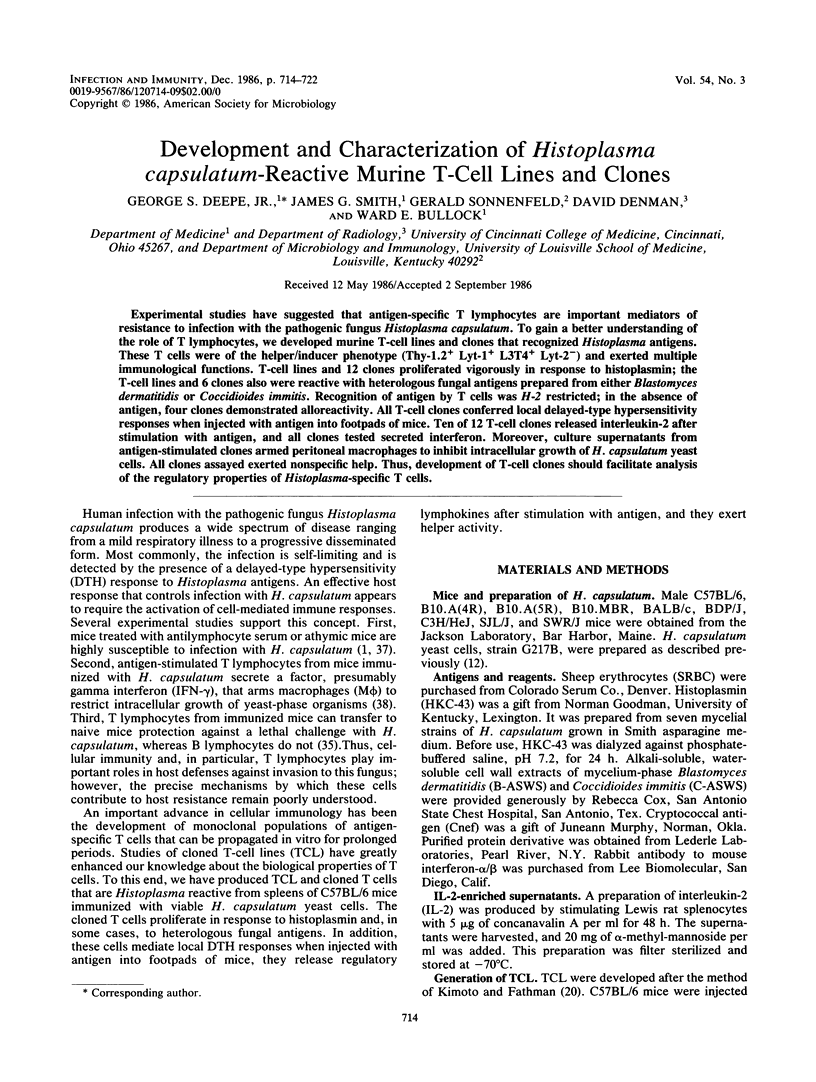
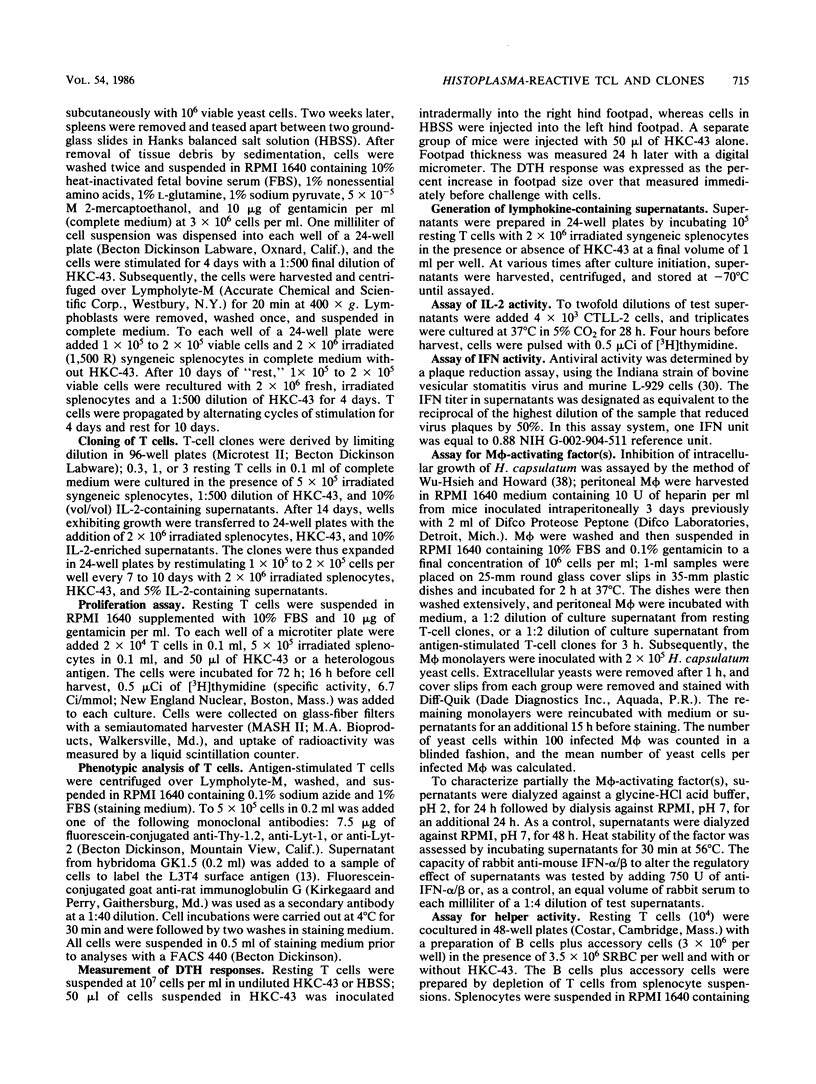
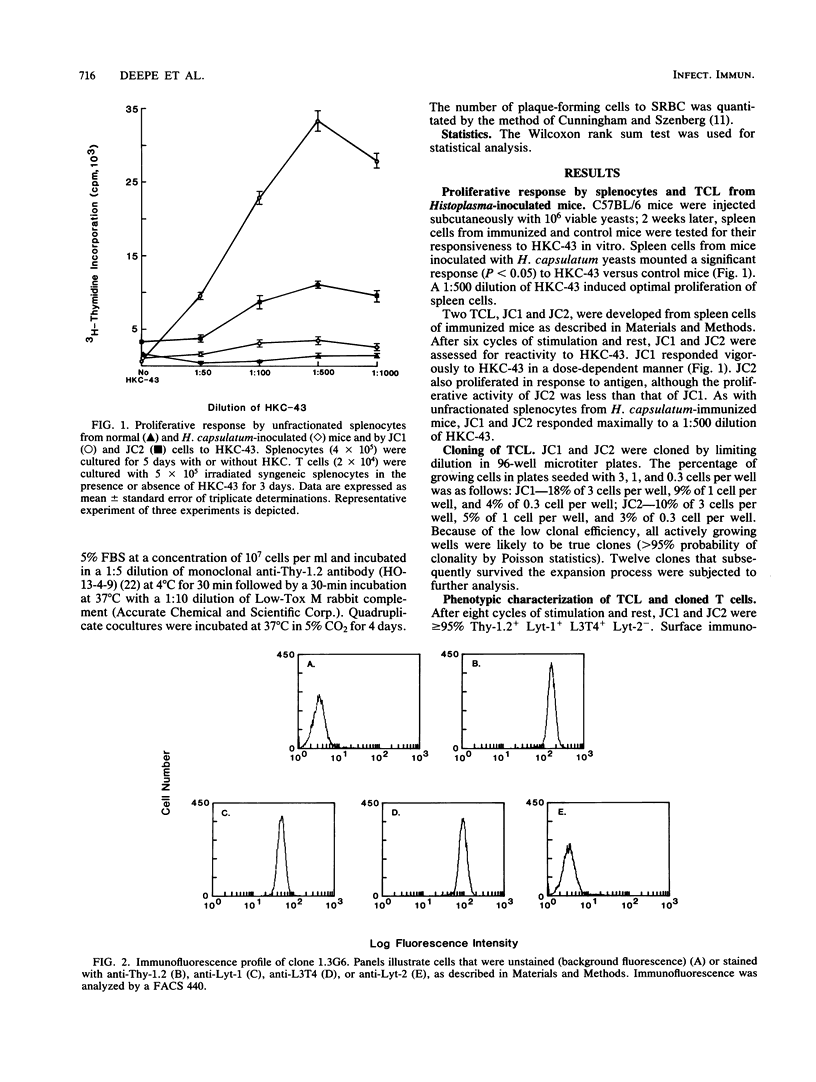
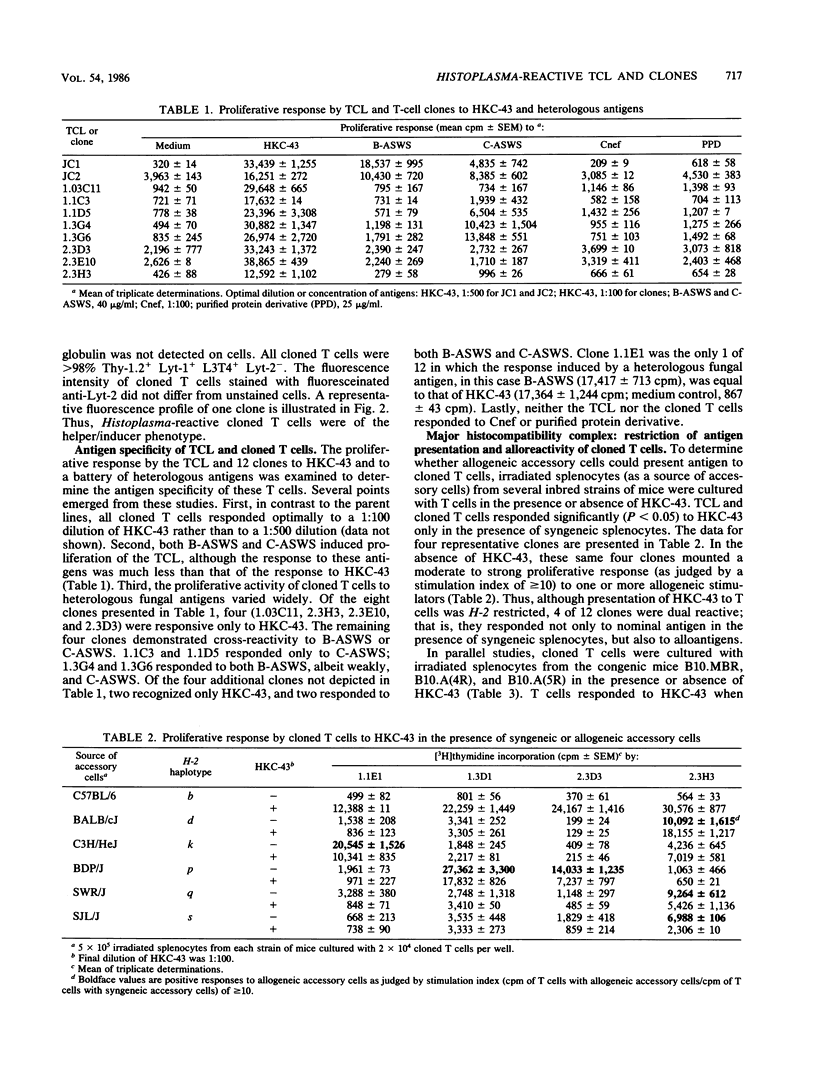
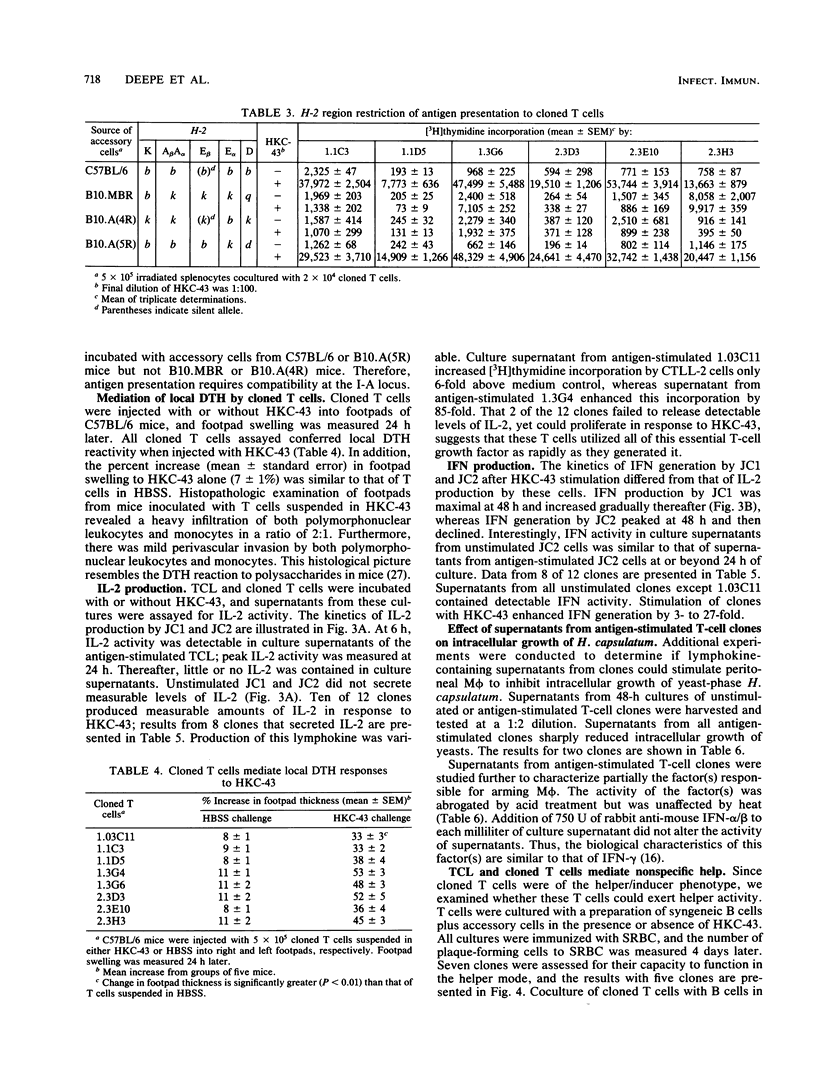
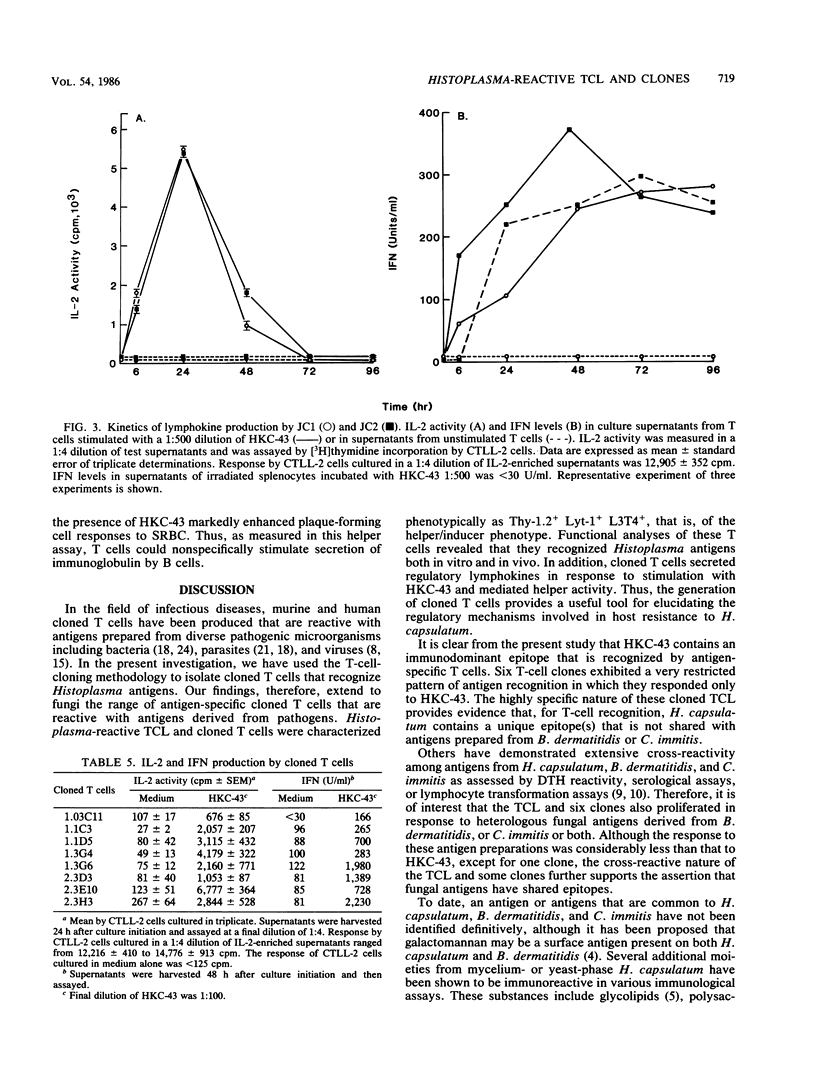
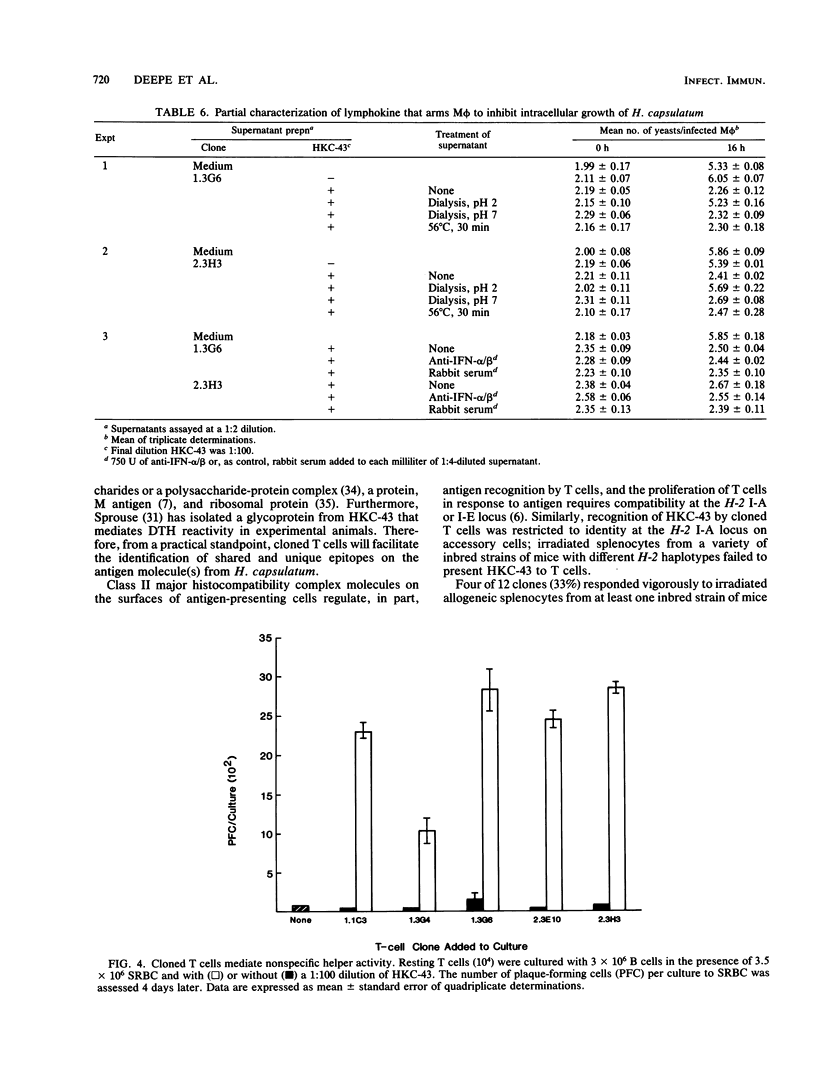
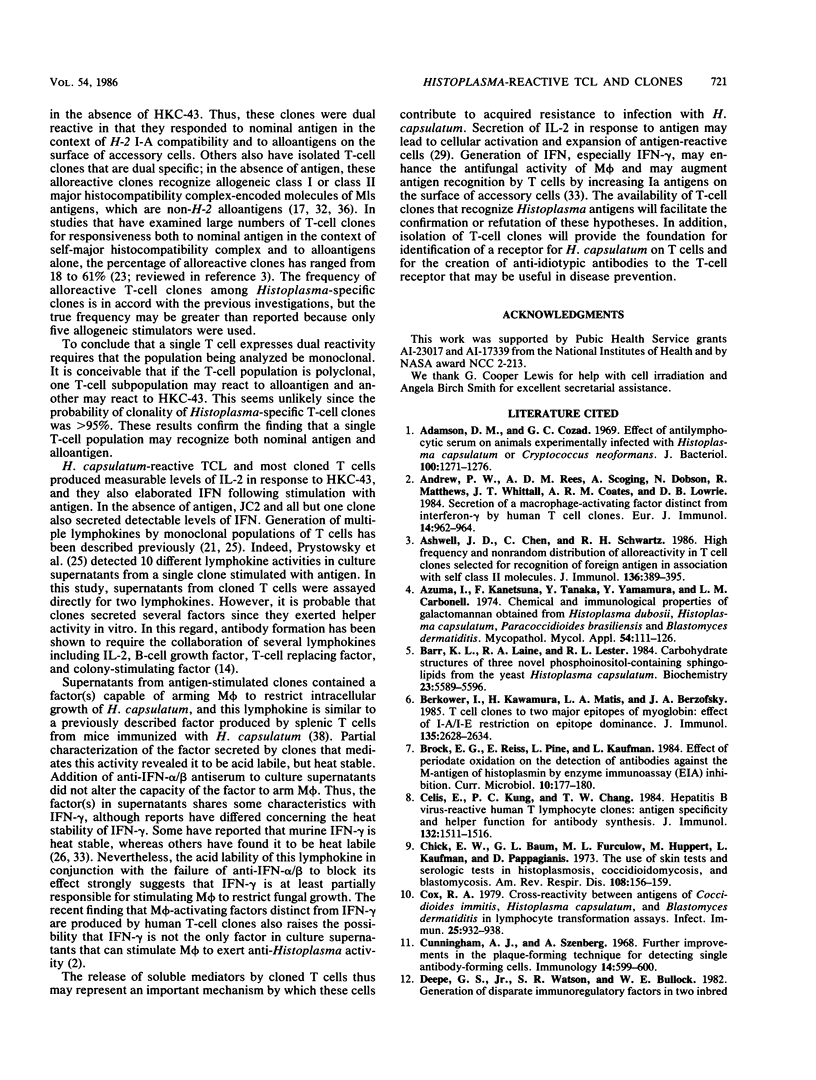
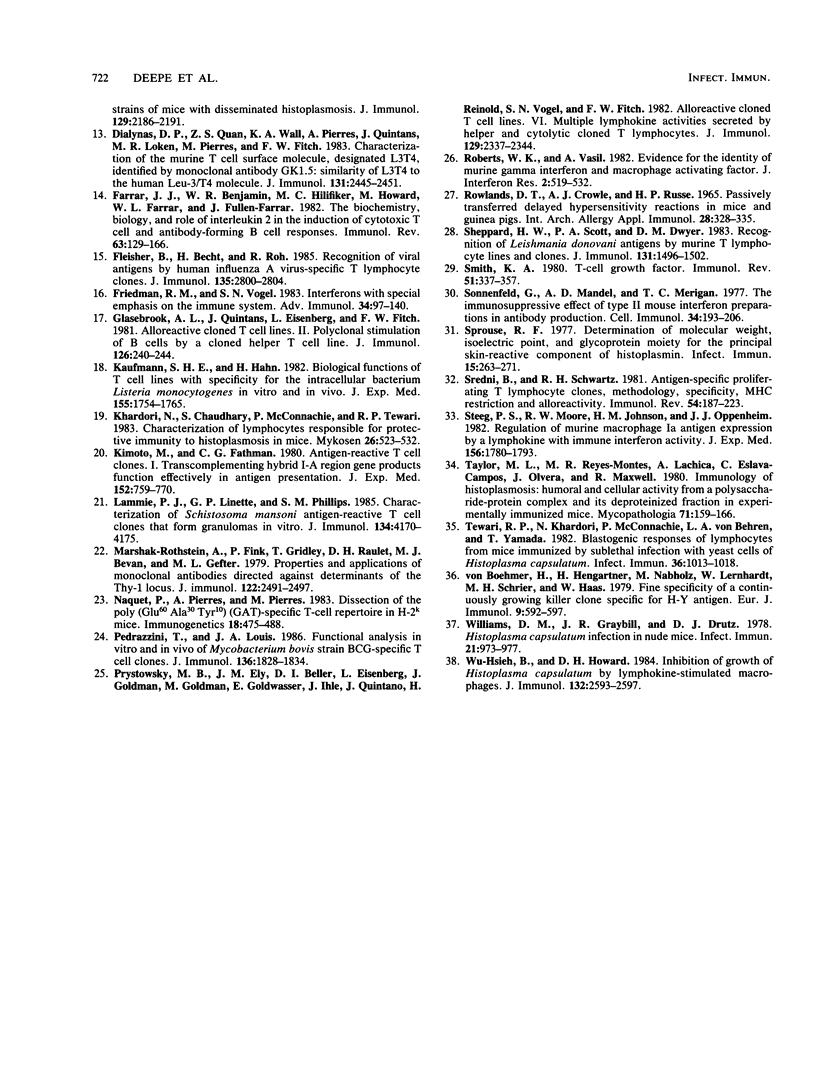
Selected References
These references are in PubMed. This may not be the complete list of references from this article.
- Adamson D. M., Cozad G. C. Effect of antilymphocyte serum on animals experimentally infected with Histoplasma capsulatum or Cryptococcus neoformans. J Bacteriol. 1969 Dec;100(3):1271–1276. doi: 10.1128/jb.100.3.1271-1276.1969. [DOI] [PMC free article] [PubMed] [Google Scholar]
- Andrew P. W., Rees A. D., Scoging A., Dobson N., Matthews R., Whittall J. T., Coates A. R., Lowrie D. B. Secretion of a macrophage-activating factor distinct from interferon-gamma by human T cell clones. Eur J Immunol. 1984 Oct;14(10):962–964. doi: 10.1002/eji.1830141018. [DOI] [PubMed] [Google Scholar]
- Ashwell J. D., Chen C., Schwartz R. H. High frequency and nonrandom distribution of alloreactivity in T cell clones selected for recognition of foreign antigen in association with self class II molecules. J Immunol. 1986 Jan;136(2):389–395. [PubMed] [Google Scholar]
- Azuma I., Kanetsuna F., Tanaka Y., Yamamura Y., Carbonell L. M. Chemical and immunological properties of galactomannans obtained from Histoplasma duboisii, Histoplasma capsulatum, Paracoccidioides brasiliensis and Blasomyces dermatitidis. Mycopathol Mycol Appl. 1974 Oct 15;54(1):111–125. doi: 10.1007/BF02055979. [DOI] [PubMed] [Google Scholar]
- Barr K., Laine R. A., Lester R. L. Carbohydrate structures of three novel phosphoinositol-containing sphingolipids from the yeast Histoplasma capsulatum. Biochemistry. 1984 Nov 6;23(23):5589–5596. doi: 10.1021/bi00318a032. [DOI] [PubMed] [Google Scholar]
- Berkower I., Kawamura H., Matis L. A., Berzofsky J. A. T cell clones to two major T cell epitopes of myoglobin: effect of I-A/I-E restriction on epitope dominance. J Immunol. 1985 Oct;135(4):2628–2634. [PubMed] [Google Scholar]
- Celis E., Kung P. C., Chang T. W. Hepatitis B virus-reactive human T lymphocyte clones: antigen specificity and helper function for antibody synthesis. J Immunol. 1984 Mar;132(3):1511–1516. [PubMed] [Google Scholar]
- Chick E. W., Baum G. L., Furcolow M. L., Huppert M., Kaufman L., Pappagianis R. Scientific Assembly statement. The use of skin tests and serologic tests in histoplasmosis, coccidioidomycosis, and blastomycosis, 1973. Am Rev Respir Dis. 1973 Jul;108(1):156–159. doi: 10.1164/arrd.1973.108.1.156. [DOI] [PubMed] [Google Scholar]
- Cox R. A. Cross-reactivity between antigens of Coccidioides immitis, Histoplasma capsulatum and Blastomyces dermatitidis in lymphocyte transformation assays. Infect Immun. 1979 Sep;25(3):932–938. doi: 10.1128/iai.25.3.932-938.1979. [DOI] [PMC free article] [PubMed] [Google Scholar]
- Cunningham A. J., Szenberg A. Further improvements in the plaque technique for detecting single antibody-forming cells. Immunology. 1968 Apr;14(4):599–600. [PMC free article] [PubMed] [Google Scholar]
- Dialynas D. P., Quan Z. S., Wall K. A., Pierres A., Quintáns J., Loken M. R., Pierres M., Fitch F. W. Characterization of the murine T cell surface molecule, designated L3T4, identified by monoclonal antibody GK1.5: similarity of L3T4 to the human Leu-3/T4 molecule. J Immunol. 1983 Nov;131(5):2445–2451. [PubMed] [Google Scholar]
- Farrar J. J., Benjamin W. R., Hilfiker M. L., Howard M., Farrar W. L., Fuller-Farrar J. The biochemistry, biology, and role of interleukin 2 in the induction of cytotoxic T cell and antibody-forming B cell responses. Immunol Rev. 1982;63:129–166. doi: 10.1111/j.1600-065x.1982.tb00414.x. [DOI] [PubMed] [Google Scholar]
- Fleischer B., Becht H., Rott R. Recognition of viral antigens by human influenza A virus-specific T lymphocyte clones. J Immunol. 1985 Oct;135(4):2800–2804. [PubMed] [Google Scholar]
- Friedman R. M., Vogel S. N. Interferons with special emphasis on the immune system. Adv Immunol. 1983;34:97–140. doi: 10.1016/s0065-2776(08)60378-8. [DOI] [PubMed] [Google Scholar]
- Glasebrook A. L., Quintans J., Eisenberg L., Fitch F. W. Alloreactive cloned T cell lines. II. Polyclonal stimulation of B cells by a cloned helper T cell line. J Immunol. 1981 Jan;126(1):240–244. [PubMed] [Google Scholar]
- Kaufmann S. H., Hahn H. Biological functions of t cell lines with specificity for the intracellular bacterium Listeria monocytogenes in vitro and in vivo. J Exp Med. 1982 Jun 1;155(6):1754–1765. doi: 10.1084/jem.155.6.1754. [DOI] [PMC free article] [PubMed] [Google Scholar]
- Khardori N., Chaudhary S., McConnachie P., Tewari R. P. Characterization of lymphocytes responsible for protective immunity to histoplasmosis in mice. Mykosen. 1983 Oct;26(10):523–532. [PubMed] [Google Scholar]
- Kimoto M., Fathman C. G. Antigen-reactive T cell clones. I. Transcomplementing hybrid I-A-region gene products function effectively in antigen presentation. J Exp Med. 1980 Oct 1;152(4):759–770. doi: 10.1084/jem.152.4.759. [DOI] [PMC free article] [PubMed] [Google Scholar]
- Lammie P. J., Linette G. P., Phillips S. M. Characterization of Schistosoma mansoni antigen-reactive T cell clones that form granulomas in vitro. J Immunol. 1985 Jun;134(6):4170–4175. [PubMed] [Google Scholar]
- Marshak-Rothstein A., Fink P., Gridley T., Raulet D. H., Bevan M. J., Gefter M. L. Properties and applications of monoclonal antibodies directed against determinants of the Thy-1 locus. J Immunol. 1979 Jun;122(6):2491–2497. [PubMed] [Google Scholar]
- Naquet P., Pierres A., Pierres M. Dissection of the poly(glu60 ala30 tyr10) (GAT)-specific T-cell repertoire in H-2Ik mice. I. GAT plus self-I-Ak-reactive T-cell clones can recognize alloactivating and/or restriction determinants on nonself-Ia molecules. Immunogenetics. 1983;18(5):475–488. doi: 10.1007/BF00364389. [DOI] [PubMed] [Google Scholar]
- Pedrazzini T., Louis J. A. Functional analysis in vitro and in vivo of Mycobacterium bovis strain BCG-specific T cell clones. J Immunol. 1986 Mar 1;136(5):1828–1834. [PubMed] [Google Scholar]
- Prystowsky M. B., Ely J. M., Beller D. I., Eisenberg L., Goldman J., Goldman M., Goldwasser E., Ihle J., Quintans J., Remold H. Alloreactive cloned T cell lines. VI. Multiple lymphokine activities secreted by helper and cytolytic cloned T lymphocytes. J Immunol. 1982 Dec;129(6):2337–2344. [PubMed] [Google Scholar]
- Roberts W. K., Vasil A. Evidence for the identity of murine gamma interferon and macrophage activating factor. J Interferon Res. 1982;2(4):519–532. doi: 10.1089/jir.1982.2.519. [DOI] [PubMed] [Google Scholar]
- Rowlands D. T., Crowle A. J., Russe H. P. Passively transferred delayed hypersensitivity reactions in mice and guinea-pigs. Int Arch Allergy Appl Immunol. 1965;28(6):328–335. doi: 10.1159/000229678. [DOI] [PubMed] [Google Scholar]
- Sheppard H. W., Scott P. A., Dwyer D. M. Recognition of Leishmania donovani antigens by murine T lymphocyte lines and clones. Species cross-reactivity, functional correlates of cell-mediated immunity, and antigen characterization. J Immunol. 1983 Sep;131(3):1496–1503. [PubMed] [Google Scholar]
- Smith K. A. T-cell growth factor. Immunol Rev. 1980;51:337–357. doi: 10.1111/j.1600-065x.1980.tb00327.x. [DOI] [PubMed] [Google Scholar]
- Sonnenfeld G., Mandel A. D., Merigan T. C. The immunosuppressive effect of type II mouse interferon preparations on antibody production. Cell Immunol. 1977 Dec;34(2):193–206. doi: 10.1016/0008-8749(77)90243-x. [DOI] [PubMed] [Google Scholar]
- Sprouse R. F. Determination of molecular weight, isoelectric point, and glycoprotein moiety for the principal skin test-reactive component of histoplasmin. Infect Immun. 1977 Jan;15(1):263–271. doi: 10.1128/iai.15.1.263-271.1977. [DOI] [PMC free article] [PubMed] [Google Scholar]
- Sredni B., Schwartz R. H. Antigen-specific, proliferating T lymphocyte clones. Methodology, specificity, MHC restriction and alloreactivity. Immunol Rev. 1981;54:187–223. doi: 10.1111/j.1600-065x.1981.tb00438.x. [DOI] [PubMed] [Google Scholar]
- Steeg P. S., Moore R. N., Johnson H. M., Oppenheim J. J. Regulation of murine macrophage Ia antigen expression by a lymphokine with immune interferon activity. J Exp Med. 1982 Dec 1;156(6):1780–1793. doi: 10.1084/jem.156.6.1780. [DOI] [PMC free article] [PubMed] [Google Scholar]
- Taylor M. L., Reyes Montes M. R., Lachica A., Eslava Campos C., Olvera J., Maxwell R. Immunology of histoplasmosis: humoral and cellular activity from a polysaccharide-protein complex and its deproteinized fraction in experimentally immunized mice. Mycopathologia. 1980 Jul 31;71(3):159–166. doi: 10.1007/BF00473064. [DOI] [PubMed] [Google Scholar]
- Tewari R. P., Khardori N., McConnachie P., von Behren L. A., Yamada T. Blastogenic responses of lymphocytes from mice immunized by sublethal infection with yeast cells of Histoplasma capsulatum. Infect Immun. 1982 Jun;36(3):1013–1018. doi: 10.1128/iai.36.3.1013-1018.1982. [DOI] [PMC free article] [PubMed] [Google Scholar]
- Williams D. M., Graybill J. R., Drutz D. J. Histoplasma capsulatum infection in nude mice. Infect Immun. 1978 Sep;21(3):973–977. doi: 10.1128/iai.21.3.973-977.1978. [DOI] [PMC free article] [PubMed] [Google Scholar]
- Wu-Hsieh B., Howard D. H. Inhibition of growth of Histoplasma capsulatum by lymphokine-stimulated macrophages. J Immunol. 1984 May;132(5):2593–2597. [PubMed] [Google Scholar]
- von Boehmer H., Hengartner H., Nabholz M., Lernhardt W., Schreier M. H., Haas W. Fine specificity of a continuously growing killer cell clone specific for H-Y antigen. Eur J Immunol. 1979 Aug;9(8):592–597. doi: 10.1002/eji.1830090804. [DOI] [PubMed] [Google Scholar]


